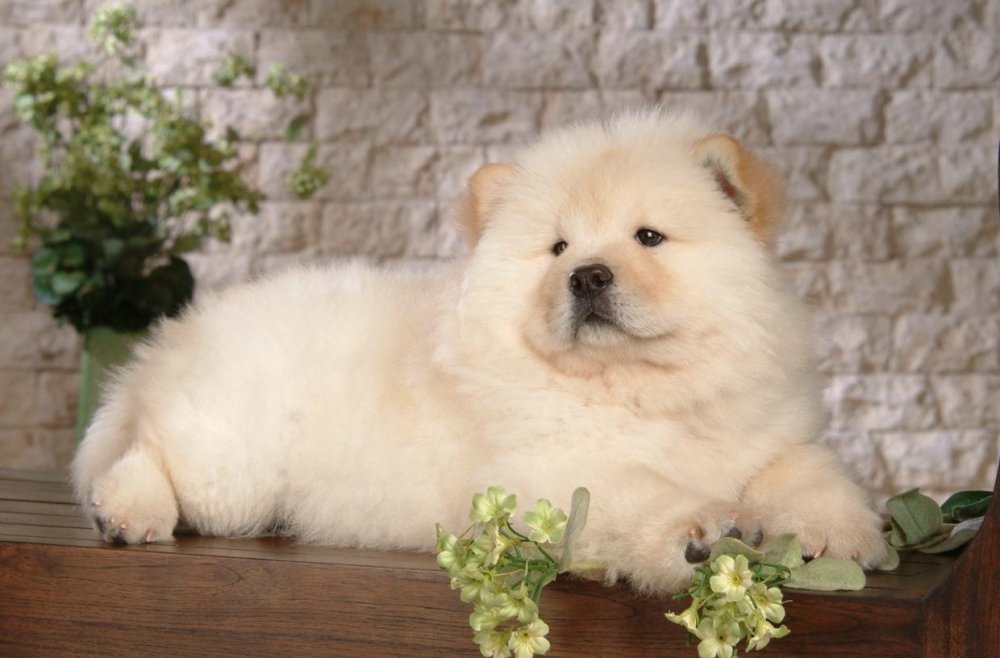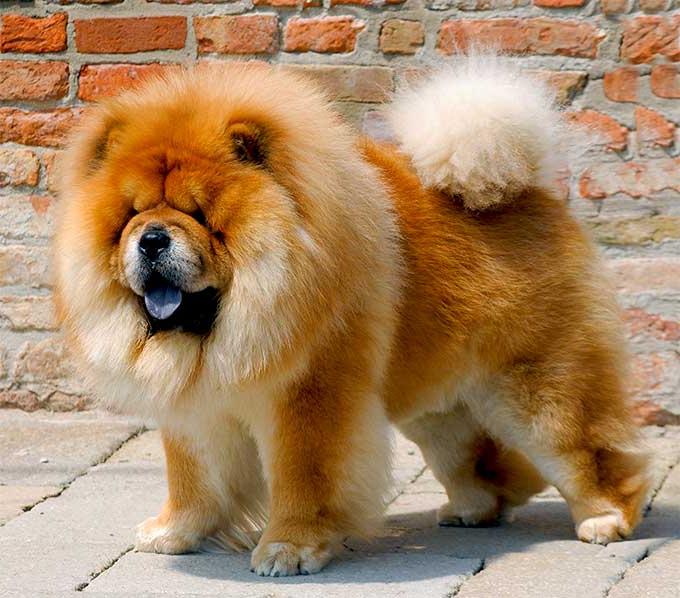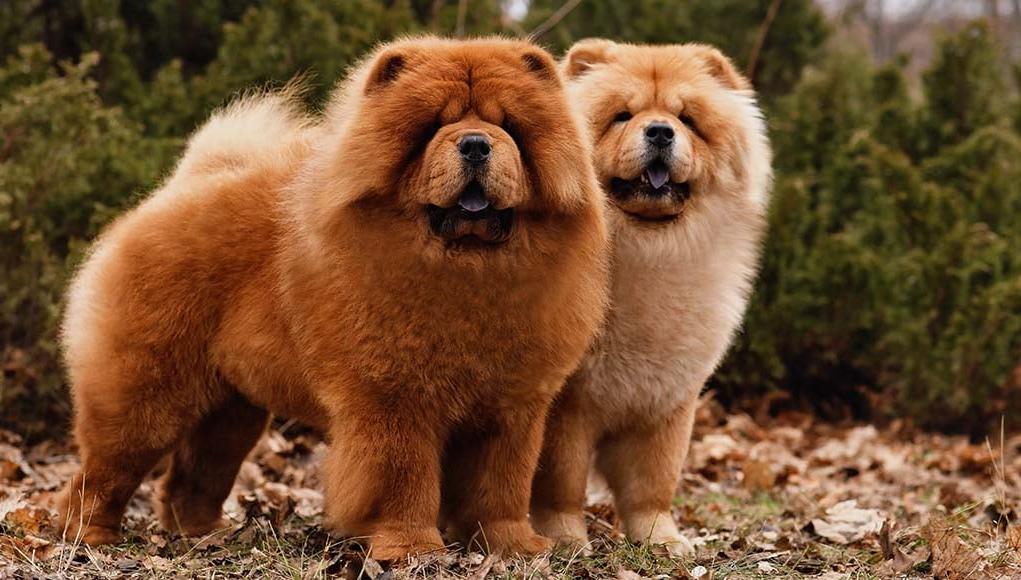- Breed Category: Non-sporting group
- Country of Origin: China
- Average Height: Males 48-56 cm, Females 46-51 cm
- Average Weight: Males 25-32 kg, Females 20-27 kg
- Average Life Span: 8-12 years
- Grooming Requirements: High, regular brushing needed
- Exercise Requirements: Moderate, daily walks
- Coat Type: Dense, double coat
- Coat Color Variations: Red, black, blue, cinnamon, cream
- Shedding Level: Moderate to high
- Ear Type: Small, triangular
- Tail Type: Curled over back
- Temperament: Aloof, independent, loyal
- Intelligence Level: Moderate
- Barking Tendency: Low
- Compatibility with Children: Moderate, supervision recommended
- Compatibility with Other Pets: Low, early socialisation needed
- Training Ease: Challenging, requires patience
- Common Health Issues: Hip dysplasia, entropion
- Dietary Needs: High-quality, balanced diet
- Energy Level: Low to moderate
- Drooling Tendency: Low
- Sensitivity to Weather: Sensitive to heat
- Overall Maintenance Level: High
- Original Purpose: Guarding, hunting
- Year of Recognition by Kennel Clubs: 1903
- Apartment Friendly: Yes, with sufficient exercise
- Best Suited For: Experienced dog owners
- Cost of Ownership: Moderate to high
- Unique Traits: Blue-black tongue
- Cultural Significance: Symbol of nobility in China
- Popularity Rank: Moderate
Ever wondered what it’s like to have a living teddy bear? Meet the Chow Chow, a breed that’s as intriguing as it is fluffy. Known for their lion-like mane and distinctive blue-black tongue, these dogs are more than just a pretty face. They carry a rich history and unique characteristics that set them apart.
Originating from northern China, the Chow Chow is one of the oldest dog breeds, with roots tracing back over 2,000 years. Initially bred for hunting, guarding, and pulling, they’ve evolved into loyal companions. This article dives into the fascinating world of Chow Chows, exploring their history, traits, and how best to care for them. Whether you’re a seasoned dog owner or a curious newcomer, there’s plenty to discover.
The Fascinating History and Characteristics of the Chow Chow

Early Development of the Breed
The Chow Chow’s journey began in the icy regions of northern China, where they were bred for their strength and versatility. These dogs were initially used for hunting, herding, and even pulling sleds. Their robust build and thick double coat made them well-suited for the harsh climates they called home. Over time, their roles evolved, but their distinctive appearance and temperament remained unchanged.
Role in Ancient Chinese Culture
In ancient China, the Chow Chow was more than just a working dog. They were considered symbols of status and wealth, often found in the homes of the elite. Their likenesses were even depicted in ancient Chinese art and pottery, highlighting their esteemed place in society. The breed’s unique characteristics, such as their lion-like mane and dignified demeanor, made them a favourite among Chinese nobility.
Key Historical Figures and Events
One of the most notable figures in the Chow Chow’s history is the Tang Dynasty emperor, who was said to have kept thousands of these dogs in his kennels. This royal endorsement helped cement the breed’s reputation as a prestigious companion. The Chow Chow’s journey to the West began in the late 18th century, when they were brought to England, capturing the fascination of dog enthusiasts worldwide.
Physical Characteristics
Chow Chows are instantly recognisable with their lion-like mane, sturdy build, and unique blue-black tongue. They have a broad skull, deep-set eyes, and a scowling expression that gives them an air of aloofness. Their thick double coat can come in various colours, including red, black, blue, cinnamon, and cream. Despite their plush appearance, Chow Chows are known for their independent and sometimes stubborn nature, requiring a confident and experienced handler.
Appearance and Unique Traits
Chow Chows are a sight to behold, with their lion-like mane and distinctive blue-black tongue. Their sturdy build and broad skull give them a powerful presence, while their deep-set eyes and scowling expression add an air of mystery. The thick double coat, which can be red, black, blue, cinnamon, or cream, not only adds to their majestic look but also provides protection against harsh weather. This coat requires regular grooming to keep it in top condition.
Temperament and Behaviour
When it comes to temperament, Chow Chows are known for their independence and aloofness. They’re not the type to fawn over strangers, often reserving their affection for family members. This breed is incredibly loyal, but they do require a confident and experienced handler. Early socialisation is key to ensuring they grow into well-rounded dogs. While they might not be the most playful, their dignified and calm nature makes them excellent companions for those who appreciate a more reserved pet.
Chow Chow as a Family Pet and Guard Dog

Typical Personality Traits
Chow Chows are known for their independence and aloofness. They often come across as reserved, especially around strangers, but their loyalty to family is unwavering. This breed is not overly affectionate, preferring to show their love in subtle ways. Their dignified nature means they’re not the type to jump up and down with excitement, but they’re always there when it counts.
Suitability as a Family Pet and Guard Dog
As family pets, Chow Chows can be a great fit for those who appreciate a more reserved companion. Their natural guarding instincts make them excellent watchdogs, alerting you to any unusual activity. However, their independent streak means they’re best suited to families who understand their unique temperament and can provide firm, consistent training.
Interaction with Children and Other Animals
Chow Chows can be good with children, especially if raised with them, but they’re not the most playful breed. They prefer calm and respectful interactions. When it comes to other animals, early socialisation is crucial. They can coexist peacefully with other pets if introduced properly, but their natural aloofness might mean they prefer their own company.
Training and Exercise Needs
Training a Chow Chow requires patience and consistency. They’re intelligent but can be stubborn, so a firm yet gentle approach works best. Regular exercise is important to keep them healthy, but they don’t need as much activity as some other breeds. Daily walks and mental stimulation are usually sufficient to keep them content.
Training, Exercise, and Health of the Chow Chow

Importance of Early Training and Socialisation
Getting a head start on training and socialisation is crucial for Chow Chows. These dogs are naturally independent and can be a bit aloof, so introducing them to different people, pets, and environments early on helps them grow into well-adjusted adults. It’s all about building their confidence and ensuring they’re comfortable in various situations.
Recommended Training Techniques
Chow Chows respond best to positive reinforcement techniques. Patience is key, as they can be stubborn. Short, engaging training sessions work wonders, keeping them interested without overwhelming them. Consistency is your best friend here, helping to establish clear boundaries and expectations.
Daily Exercise Requirements and Activities They Enjoy
While Chow Chows don’t need as much exercise as some high-energy breeds, they still benefit from daily walks and playtime. A couple of short walks each day, combined with some mental stimulation, usually keeps them happy. They enjoy activities that challenge their minds, like puzzle toys or basic obedience games.
Health and Lifespan
Chow Chows are generally healthy, but like all breeds, they’re prone to certain health issues. Regular vet check-ups and a balanced diet are essential to keep them in top shape. With proper care, they typically live between 8 to 12 years. Keeping an eye on their weight and ensuring they get enough exercise can help them lead a long, healthy life.
Health and Care for Your Chow Chow

Common Health Issues
Chow Chows, with their unique build and coat, can face specific health challenges. Hip dysplasia and elbow dysplasia are common due to their sturdy frame. They’re also prone to eye issues like entropion, where the eyelid rolls inward. Regular vet visits are crucial to catch these early.
Average Lifespan and Health Tips
With proper care, Chow Chows can live between 8 to 12 years. A balanced diet and regular exercise are key to their longevity. Keep an eye on their weight, as obesity can exacerbate joint issues. Regular check-ups will help ensure they stay healthy and happy.
Preventative Care Recommendations
Preventative care is all about staying ahead of potential problems. Regular vaccinations, flea and tick prevention, and dental care are essential. Consider joint supplements if your vet recommends them, especially as your Chow ages.
Grooming and Maintenance
Their thick double coat requires regular grooming to prevent matting and reduce shedding. Brush them at least twice a week, and more during shedding seasons. Regular baths and nail trims will keep them looking their best. Don’t forget to check their ears and clean them as needed to prevent infections.
Coat Care and Grooming for Your Chow Chow

Coat Care and Grooming Routines
Chow Chows boast a thick double coat that demands regular attention. To keep their fur in top condition, brush them at least twice a week. This helps prevent matting and keeps their coat looking lush. During shedding seasons, you might need to increase the frequency to daily brushing. A slicker brush and a metal comb are your best friends here, helping to reach through the dense undercoat.
Shedding and Seasonal Grooming Tips
Chow Chows shed heavily twice a year, usually in spring and autumn. During these times, a more rigorous grooming routine is essential. Regular baths can help manage shedding, but ensure their coat is thoroughly dried to prevent skin issues. A high-velocity dryer can be handy for this task, blowing out loose fur and keeping their skin healthy.
Diet and Nutrition
A balanced diet is crucial for maintaining your Chow Chow’s health and coat quality. Opt for high-quality dog food that meets their nutritional needs, focusing on protein and healthy fats. Omega-3 and Omega-6 fatty acids are particularly beneficial for their skin and coat. Always provide fresh water and monitor their weight to prevent obesity, which can lead to joint problems.
Nutritional Needs and Feeding for Your Chow Chow

Nutritional Needs for Optimal Health
Chow Chows thrive on a balanced diet rich in protein, healthy fats, and essential vitamins. Look for high-quality dog food that lists meat as the first ingredient. Omega-3 and Omega-6 fatty acids are particularly beneficial for their skin and coat, helping to maintain that lush, fluffy appearance.
Foods to Include and Avoid
Include lean meats, fish, and vegetables in their diet. Avoid foods high in fillers, artificial preservatives, and excessive grains, as these can lead to allergies and digestive issues. Treats should be given sparingly to prevent weight gain.
Feeding Schedules and Portion Recommendations
Feed your Chow Chow twice a day, once in the morning and once in the evening. Portion sizes depend on their age, weight, and activity level, so consult your vet for specific recommendations. Always provide fresh water.
Fun Facts and Trivia
Did you know the Chow Chow’s blue-black tongue is a unique trait shared with only one other breed, the Shar Pei? This distinctive feature adds to their mystique and charm.
Interesting Tidbits and Famous Chow Chows

Interesting Tidbits about the Breed
Chow Chows are full of surprises. One of their most intriguing features is their blue-black tongue, a trait they share with only one other breed, the Shar Pei. This unique characteristic adds to their allure and mystique. Historically, these dogs were known as “Songshi Quan” in China, which translates to “puffy-lion dog,” a fitting name given their majestic mane and dignified presence. Despite their plush appearance, Chow Chows are known for their independent nature, often likened to that of a cat.
Famous Chow Chows in Media and History
Chow Chows have made their mark in history and media. One of the most famous Chow Chows was owned by Sigmund Freud, the father of psychoanalysis. Freud’s Chow, Jofi, was said to have attended therapy sessions, providing comfort to patients. In the world of entertainment, Martha Stewart’s Chow Chow, Genghis Khan, has often been featured in her publications and TV shows, showcasing the breed’s regal charm. These dogs have also appeared in various films and TV series, often cast for their distinctive looks and calm demeanour.
Final Thoughts

The Chow Chow is a unique blend of history and elegance. With their distinctive appearance and independent nature, they offer a rewarding companionship for those who appreciate their dignified demeanor. While they present challenges in training and socialization, the loyalty and protection they provide are unparalleled. Embracing a Chow Chow means committing to understanding and nurturing their unique traits. For those ready to embark on this journey, the rewards are as profound as the breed’s rich heritage.
